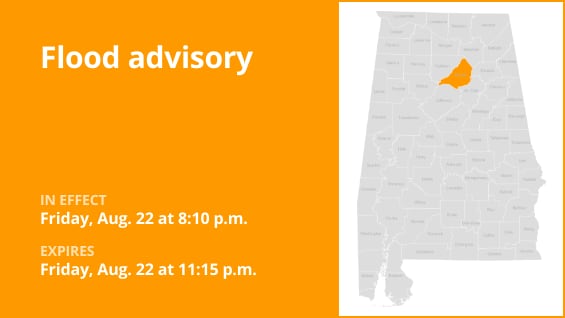The National Weather Service issued a flood alert for Blount County at 8:10 p.m. Friday, which was in force until 11:15 p.m.
“Urban and small stream flooding caused by excessive rainfall is expected,” the weather agency continues.
“Low-lying and poorly-drained locations may experience minor flooding. roads covered in water. overflowing areas with inadequate drainage. Stream or river flows are higher. Water ponding in urban or other regions is happening or may happen soon, according to the weather service. “When you come across flooded roads, turn around to avoid drowning. Vehicles are the primary cause of flood fatalities. At night, when it is more difficult to identify the risks of flooding, use extra caution. Avoid driving on flooded roads and pay attention to your surroundings. Avoid being swept away. Culverts and riverbanks may become hazardous and unstable. There are hundreds of low-water crossings in steep areas, which could be hazardous during periods of intense precipitation. Avoid trying to cross roadways that are flooded. Look for a different path.
Your guide to weather alerts: advisories, watches, and warnings
-
Flash flood warning: Take action!
When a flash flood is approaching or already happening, a warning is sent. Get to high ground right away if you’re in a flood-prone location. A flash flood is a quick, intense flood that can form in a matter of minutes to hours. Even in places that don’t get rain right away, flash floods can happen.
-
Flood warning: Take action!
When flooding is expected or is happening, a flood warning is issued.
-
Flood advisory: Be aware:
When flooding is not predicted to be severe enough to warrant a warning, a flood advisory is issued. But if care is not taken, it could result in circumstances that endanger life and/or property and cause a great deal of discomfort.
-
Flood watch: Be prepared:
When the weather is conducive to flooding, a flood watch is issued. Although it doesn’t ensure flooding will happen, it does indicate that it is a potential.
Staying safe during a flood: Recommendations from the weather service
Floods can be a serious hazard, particularly if you live in a flood-prone location or camp in a low-lying area. The weather service provides crucial flood protection instructions to protect you:
Look for higher ground.
Moving to higher ground should be your first course of action if you’re camping in a low-lying location or in an area that is prone to flooding.
Respect evacuation directives:
Immediately comply with any evacuation orders issued by local authorities. Make sure your house is locked before you leave.
Cut off appliances and utilities:
Disconnect your appliances and utilities if you have the time. By taking this precaution, electrical dangers during flooding are reduced.
Avoid drowned places and flooding basements:
Avoid basements or rooms with electrical outlets or cords submerged in water. This lessens the chance of electrical mishaps.
Quick evacuation to keep you safe:
Evacuate right away if you see sparks or hear popping, crackling, snapping, or buzzing noises. Avoid going into water that might be electrically charged.
Avoid going on foot in floodwaters:
Even if floodwaters seem shallow, you should never try to go over them. You can be swept off your feet with power by just 6 inches of swift-moving water.
If you’re stuck, look for high ground:
If you find yourself caught by flowing water, move to the highest spot you can and dial 911 to reach rescue personnel.
floods is a possibility when there is a lot of rain, especially in areas that are low-lying and prone to floods. No matter how deep the water looks, it is crucial to never try to drive through it on the road. The weather service claims that most cars can be washed away by rushing water as little as 12 inches. Put your safety first by being aware and ready.
Mastering wet roads: Safety tips for heavy rainfall
Safety comes first when there is a lot of rain. To avoid dangers and navigate wet roads, arm yourself with these weather service guidelines:
Watch out for swift water flow:
Avoid parking or strolling close to drainage ditches or culverts during periods of intense rain, since the swift-moving water can be quite dangerous.
Keep your distances from other vehicles safe:
Keep a safe distance from the automobile ahead of you by following the two-second rule, and give yourself an extra two seconds if it’s raining a lot.
Reduce your speed and exercise caution:
Reduce your speed if it’s raining and the roads are wet. Reduce your speed gently by taking your foot off the accelerator. Never apply the brakes abruptly since this could cause the vehicle to slide.
Pick your lane carefully:
On multilane highways, stay in the middle lanes to reduce the chance of hydroplaning because water tends to pool in the outer lanes.
Visibility is important.
Turn on your headlights to improve visibility in severe rain. Rain-stained windows can make it difficult to see cars in blind spots, so be especially alert for them.
Be cautious on slick roads:
Because of a combination of rain, oil, and grime, roadways are at their slickest during the first 30 minutes of precipitation. Be especially careful during this time.
Stay a safe distance away from big cars:
Tire spray from big vehicles and buses can make it harder to see. Be careful when passing and refrain from tailgating.
Be mindful of your wipers:
-
Overloaded wiper blades can hinder visibility. If rain severely limits your sight, pull over and wait for conditions to improve. Seek refuge at rest areas or protected spots.
-
When stopping by the roadside is your only option, position your vehicle as far off the road as possible, ideally beyond guardrails. Keep your headlights on and activate emergency flashers to alert other drivers of your position.
You may greatly lower dangers and protect your health when it rains a lot by adhering to these safety precautions. To ensure a safe and sound voyage, keep yourself updated on weather conditions and follow local authorities’ instructions.
United Robots offers a service called Advance Local Weather Alerts that gathers the most recent information from the National Weather Service using machine learning.






